Dispatch of Medical Professionals
Home > Dispatch of Medical Professionals > Dispatch List > HICARE Mission to Korea
HICARE Mission to Korea
Period:
Members:
| Leader | Jitsuro Yanagida | HICARE Chief Executive Secretary, Permanent Director, Hiroshima Medical Association |
| Member | Noritomo Seno | Hiroshima City Medical Association |
| Koich Tanigawa | HICARE Executive Secretary, Professor of Hiroshima University Graduate School | |
| Masashi Hieda | Doctor, Radiation Emergency Medicine Promotion Center, Hiroshima University Hospital | |
| Masaharu Hoshi | HICARE Executive Secretary, Professor, Hiroshima University Research Institute for Radiation Biology & Medicine | |
| Hideo Sasaki | HICARE Executive Secretary, Director of Health Management and Promotion Center at Hiroshima A-bomb Casualty Council | |
| Mariko Kurose | Assistant Chief, Nursing Department, Hiroshima Red Cross Hospital & Atomic-bomb Survivors Hospital | |
| Two HICARE Secretariats |
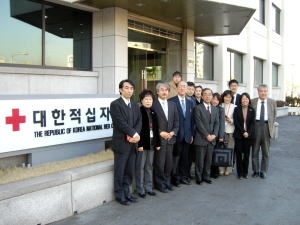
HICARE Delegation with staff of the Republic of Korea National Red Cross
Institutes/Hospitals visited (in order of visit):
Korea Institute of Radiological & Medical Sciences
Radiation Health Research Institute
The Republic of Korea National Red Cross
Yeungnam University Medical Center
Busan Veterans Hospital
Impressions:
The invitation of overseas doctors actively involved in the treatment of radiation victims (and the provision of their training within Hiroshima) is one of HICARE’s main projects. Since 1991, the year of HICARE’s establishment, the organization has invited trainees from three countries, located in both South and North America. In addition, since 1999, HICARE has every year invited doctors from Korea.
However, there have been situations where busy medical staff, despite a desire to undertake training in Hiroshima, could not manage to leave their post for the one to three month training period. Hospitals in Korea thus suggested that HICARE prepare a shorter period training program.
In response, a short-term program, a one-week stay in Hiroshima (five days of training for six participants; either doctors or nurses) was proposed to HICARE's Board of Executive Secretaries. A trainee would work at several HICARE related organizations, undertaking a variety of training programs: epidemiology on the after-effects of the A-bomb, a general outline of radiation treatment, general formalities with regards to radiation medicine, etc.
Furthermore, since October 2005, a new system allowing local doctors to approve overseas medical certificates was launched, a procedure necessary for Korean residents to receive the Atomic Bomb Health Care Allowance. We hope that trainees acquire the knowledge necessary regarding paperwork and other formalities: how to specify diseases, how to describe in detail the patients condition on the application form, etc.
In Japan, an emergency radiation medicine network has been already established; its headquarters in western Japan is located at Hiroshima University. In Korea, a similar network has recently been established; a delegation from the Korean network visited Hiroshima and undertook training.
HICARE also dispatched a delegation (six doctors, one nurse, and two secretariats) to four hospitals that actively provide medical treatment for A-bomb survivors, as well as to two institutes that play key roles in the Korean Emergency Radiation Medicine Network. I was appointed leader of the delegation, being Chief Executive Secretary to the Board. The aims of the delegation were:
To investigate how HICARE can help support A-bomb victims living in Korea;
To specifically discuss a short-period training program.
Regarding radiation emergency medicine, we visited the Korea Institute of Radiological & Medical Sciences and the Radiation Health Research Institute in Seoul; each plays a central role in radiation-emergency medical care. At each institute, we attended lectures concerning both the outline of the network and the role of the executive staff. In turn, I explained both the outline of HICARE and the short-period training program. After hearing impressions from HICARE trainees, we exchanged mutual opinions enthusiastically, hearing additional explanations and questions mainly from Dr. Tanigawa, Professor at Hiroshima University and a leading doctor in emergency radiation medical care in Hiroshima. We ended by touring each facility.
As a hospital that provides significant treatment for A-bomb survivors, we visited the Korean Red Cross in Seoul, the Yengnam University Hospital in Daegu, and the Busan Veterans Hospital in Busan. We met with the executive staff of both institutions, including each hospital director. We received explanations regarding both the hospital and their medical care for radiation-exposed patients. I briefly outlined HICARE's history, activities, and new short-period training, I also mentioned that we would very much like the opportunity to train doctors from the Korean Red Cross. In addition, listening to impressions from former Korean HICARE trainees, we were glad to hear that their experience contributed to their medical activities after they returned to Korea.
After explanations regarding overall medical care for radiation victims (including some remainders from Dr. Sasaki regarding the medical certificate for receiving the health care management allowance) we exchanged opinions and requests with one another. HICARE’s short-term program proposal was received with great joy, beyond even our own expectations. HICARE's short-period program was welcomed by every hospital, and they spoke of their intention to dispatch several doctors from each hospital every year.
At the Korea Red Cross Hospital in Daegu, as well as the Busan Veteran’s Hospital, we met with numerous A-bomb survivors.
To conclude, seeing each hospital’s/institute’s efforts with regards to health care for radiation victims and hearing of their willingness to send trainees, I feel the delegation to Korea was even more beneficial than originally anticipated.
(Written by Jitsuro Yanagida, M.D.)
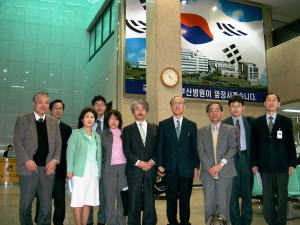
Dr.Seno(4th from the right) At Busan Veterans Hospital

Dr.Tanigawa(3rd from the right, front row) at National Radiation Emergency Medical Center
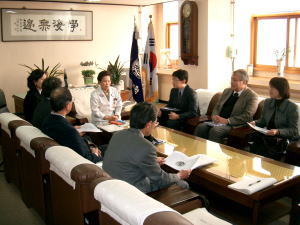
Dr.Hieda(3rd from the right) at Yeungnam University

Dr.Hoshi(middle, back row) at Radiation Health Research Institute
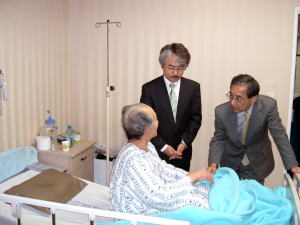
Dr.Sasaki(right) at Daegu Red Cross Hospital
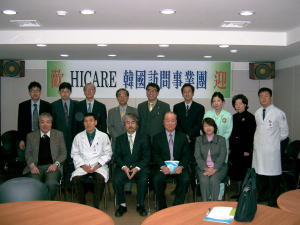
Ms.Kurose(for right, from row) with staff of Daegu Red Cross Hospital



